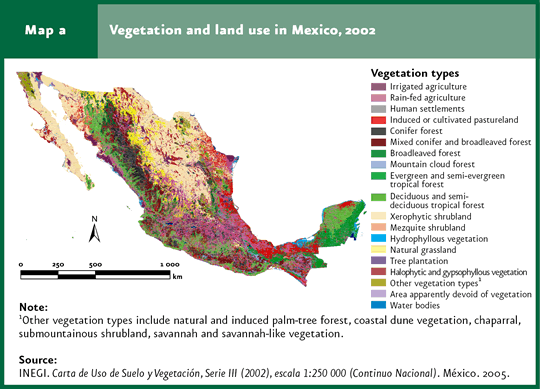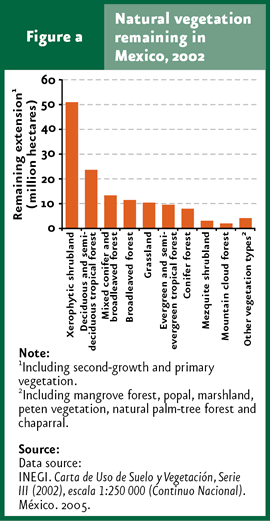The vegetation of Mexico is highly heterogeneous. The National Institute of Statistics and Geography (INEGI in Spanish) uses a hierarchical classification system that considers the plant forms at the highest level, characterized in terms of physiognomic and ecological features (e. g. forest, tropical rainforest, shrubland, etc.), including within each of these forms the types of communities defined according to physiognomic, ecological and plant-composition features (e. g. chaparral, rosette-shaped, succulent, cloudy mountain, etc.) and the vegetation types combining the name of the formation with the type of community (e. g. cloudy mountain forest, succulent shrubland, etc.). The types most widely distributed in the country are the following (Map a):

Coniferous forest. Vegetation dominated by evergreen conifer trees, including pine (Pinus) and fir (Abies) as the two genera most widely distributed, followed by Douglas fir (Pseudotsuga), juniper (Juniperus) and cedar (Cupressus). These forests usually prosper in temperate and cold climates at moderately high altitudes in mountain ranges. Conifers, and specially pine trees, are the tree types most heavily exploited in Mexico for industrial uses. In some cases, this vegetation type is favored by anthropogenic disturbances (e. g, forest clearing or wild fires).
Oak forest. Vegetation dominated by broad-leaved trees, primarily oak (Quercus), most of them deciduous. These are frequently also named broad-leaved forests. These occur mostly in temperate climates in mountains, frequently below the altitude dominated by conifers, although occasionally may develop in warmer places. This vegetation type is primarily used to produce carbon fuel and for cattle raising. Given that soil fertility in oak forests is frequently very high, this is commonly used for agricultural practices.
Conifer and broad-leaved (oak) forest. In some areas these two groups of trees coexist, forming mixed forests. This coexistence is frequently favored by human activity; the exploitation of these forests is similar to that in pine or oak forests.
Cloudy mountain forest. Vegetation characterized by a dense tree cover with the coexistence of several genera, including Liquidambar, Magnolia, Juglans, Ostrya, Clethra, Podocarpus, Turpinia, Oreopanax and many more. Pines and oaks are a frequently present as well. One of the key features is the temperate and tropical affinity of species present in the canopy and understory, respectively. This vegetation type grows at altitudes where fog banks are formed. This forest type is exuberant, with a large amount of ferns and lianas, as well as plants growing on trees (epiphytes). An important portion of the flora growing in cloudy mountain forests in Mexico is endemic of the country. Broad areas originally covered by this forest have been cleared for use in agriculture, and in several regions coffee is grown under the canopy of trees.
Evergreen and semi-deciduous tropical rainforests. Vegetation dominated by trees of many species, in rainy and warm areas. The canopy of trees may reach more than 40 meters in height and keeps an important portion of the leaves throughout the year. According to the canopy height, this vegetation type can be divided into high rainforests (trees measuring over 30 meters), mid-sized forests (between 20 and 30 meters) and low rainforests (frequently ranging between 4 and 15 meters high). Several vegetation strata of various heights develop under the tallest trees. This vegetation type is among the most diverse biological communities worldwide. The exploitation of some high-value species such as mahogany (Swietenia) or the red cedar (Cedrella) along with several non-timber forest products is a common practice in these plant communities.
Deciduous and sub-deciduous forests. Vegetation dominated by trees of several deciduous species, which develops in warm environments with marked differences between the rainy and dry seasons. Similar to evergreen rainforests, these are divided into mid-sized and low forests according to the height of the dominant tree vegetation. The canopy rarely exceeds 15 meters high, although occasionally it may reach up to 30 meters. The categorization as sub-deciduous or deciduous forest depends on the proportion of trees shedding their leaves during the dry season. Most trees store water in the stem, as in the case of copal (Bursera), pochote (Ceiba)and several columnarcacti. This vegetation type is frequently subjected to the slash-and-burn agriculture and extensive cattle raising. These activities exert a heavy impact on this vegetation type, making of it one of the most severely threatened tropical ecosystems in the world.
Mezquital. Vegetation dominated by spiny trees, mostly mesquite trees (Prosopis). It is distributed in relatively arid climates. These trees keep their leaves over the dry season, as they extract ground water through long roots. These grow in deep and smooth soils, suitable for agriculture, which has resulted in heavy habitat destruction. Other mezquital stands are subjected to heavy grazing.
Xerofilous shrubland. This category includes a diverse and extensive set of vegetation types (rosette-shaped, succulent, shrublands, etc.). This is dominated by shrubs and characterizes arid and semi-arid zones. The number of endemisms in these areas is extremely high. Due to the scarcity of water and given that soils are poor and thin, agriculture is practiced at small scale, except when irrigation is available. By contrast, cattle raising is practiced extensively, and broad areas originally covered by xerofilous shrubland are heavily overgrazed.
Grassland. Vegetation dominated by herbaceous plants, mostly grasses. It grows in any climate, but mostly in the country’s northern semiarid regions and in the highest portions of virtually all mountains (above four thousand meters above sea level). Almost all of Mexico’s grasslands are used for cattle raising, leading to overgrazing in most cases. Other grasslands were previously forests or shrublands, but cattle and wildfires keep them under this altered vegetation form. These grasslands are known as induced grasslands.
Of the remaining area of these vegetation types in the year 2002, the xerofilous shrubland was the most abundant, while meszquital and cloudy mountain forests where among the most scarce ones (Figure a).

Additional vegetation types include mangle forests, various types of wetlands, palm forests, peten vegetation y chaparral, covering relatively small areas and related to specific climatic, edaphic or hydrological conditions.
Reference:
Adapted from: Semarnat. Informe de la Situación del Medio Ambiente en México. Compendio de Estadísticas Ambientales 2005. México. 2005.
|